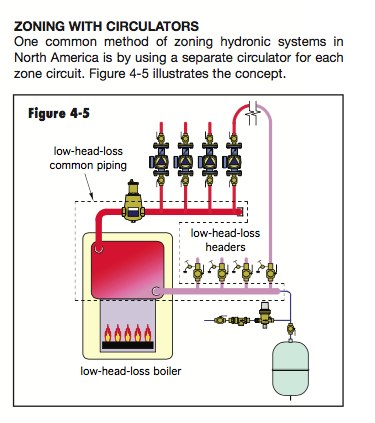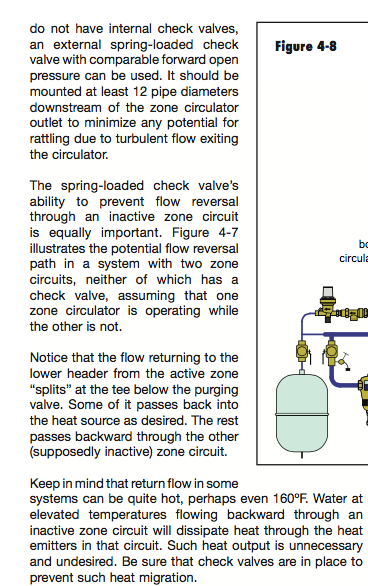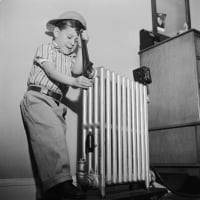Flow check no check?
Comments
-
Well, I would prefer the flow check to be on the pump discharge but since they put the pumps on the return line you cant without re-piping.
Looks like you are missing a flo check for the indirect.
I would put the flow check in the horizontal supply pipe to the indirect. To the right of the ball valve with the white handle0 -
There's no check inside that black pump?0
-
Some pics would help.0
-
Oops just saw the pick.0
-
I'm guessing not, due to the temp change of the pipes going to and from the tank during a call for heat from either of the zones. I also noticed that the faucet water got alot hotter after turning up the boiler temp. I was told that the trap on the return would keep this from happening, but...0
-
Your real concern should be that the way the boiler is piped is such that the pumps are pumping into the expansion tank not away front he expansion tank. That's the first thing I would do and of course then add the internal flow checks for all 3 pumps ore separate external flow checks.1
-
We have had a rash of those nicely piped systems pumping at the expansion tank, lately??
You may need to add the checks into all the pumps and a second one on the supply to the indirect to get 100% flow shut off to the indirect. the tanks, when cold tend to induce a thermo siphon and may need better flow check protection.
In a perfect world, pumps would move up to the supply downstream of the expansion tank.
And it may be possible to run a single pump with zone valves, but I doubt you want to redo that much?Bob "hot rod" Rohr
trainer for Caleffi NA
Living the hydronic dream0 -
The pumps on the return are one topic, the lack of checks another.
Seems like you need a check, yes install one on that horz pipe above the tank
The "trap" philosophy on the existing set up in not flying0 -
You will get by with some of the above mentioned suggestions....Come spring consider a complete repipe...Send the p brain that installed it a picture after the fact..Along with a donation envelope....0
-
So it seems the pumps on the return is not good? this seams to be the standard for my installer, or x-installer. To move pumps is obviously a total repipe - what are the major disadvantages and are the benefits worth that?0
-
It very tough to prevent unwanted flow without check protection on the supply side of the boiler.dmk said:So it seems the pumps on the return is not good? this seams to be the standard for my installer, or x-installer. To move pumps is obviously a total repipe - what are the major disadvantages and are the benefits worth that?
Hot goes to cold and you will always get some thermosiphon potential with pumps on the return and no check protection.
Multiple circulators connected to a common header will alwys require check protection that applies to pumps on the supply also.
indirect tanks may require check on both supply and return to prevent ghost flows.
Here is a good read on the most common mistakes seen in hydronics and the explanation on how and why.
http://www.caleffi.com/sites/default/files/coll_attach_file/idronics_19_na.pdf


Bob "hot rod" Rohr
trainer for Caleffi NA
Living the hydronic dream0 -
Looks like your installer wasn't a believer in purge valves?0
-
Pumps on the supply piping pumping away from the expansion tank is much preferred.
Pumps on the returns only work on systems with low piping resistance.
That being said add a flow check to what you have, it may not be perfect but will improve things.0 -
Well thanks for the input guys. what would determine a low resistance system?0
-
The boiler you have is a sectional cast iron type, very little flow resistance through that type of heat exchanger.
Baseboard loops piped with 3/4 or larger tube, I suspect? Also low pressure drop.
How many feet of baseboard? You are possibly only needing to move 4 or 5 gpm through the system.
Boilers with small diameter coiled heat exchangers and long, small diameter radiant loops would be an example of a higher pressure drop system.Bob "hot rod" Rohr
trainer for Caleffi NA
Living the hydronic dream0 -
Right on hot rod - Currently pump 1 (1st floor) says 2 gpm and pump 2 (2nd floor) says 3 gpm. Knowing this, would a repipe really be worth it?hot rod said:The boiler you have is a sectional cast iron type, very little flow resistance through that type of heat exchanger.
Baseboard loops piped with 3/4 or larger tube, I suspect? Also low pressure drop.
How many feet of baseboard? You are possibly only needing to move 4 or 5 gpm through the system.
Boilers with small diameter coiled heat exchangers and long, small diameter radiant loops would be an example of a higher pressure drop system.0 -
Flow Check dilemma aside
With the low flow resistance of this boiler and piping could he move the PONPC to the end of his return header and make his system pump away easy enough?0 -
One improvement in my opinion would be to repipe and put the pumps on the supply side. if the system performs to your liking with the addition of flow checks, no need to go further.
A success would be no ghost flow, over-heating of the indirect and 100% air free operation.
It is possible the boiler may be over sized and that will lead to short cycling on all but design conditions, perhaps? How many feet of baseboard connected to that boiler and what size is the boiler DOE rating?
IF you decide to repipe a single circulator and 3 zone valves would be my first choice. I suspect one of those Alphas has enough "fizz" to handle the entire heating load, and DHW on priority.
The delta P circulators like that are ideal matches for zone valved systems, they automatically adapt and learn the systems flow requirements, low power consumption and pumping just the correct flow under changing loads.
There are still installation manuals that show systems piped like yours. It can and does move heat energy, I assume? But several of the glitches could be eliminated by pumping and or zoning on the supply side. Only then do you get 100% shut off of flow to eliminate un-wanted ghost flow conditions.Bob "hot rod" Rohr
trainer for Caleffi NA
Living the hydronic dream0 -
Ok thanks again. flow check for now and see how it goes!0
-
All of these circs have the provisions to add a flocheck on the discharge side. They are already machined to accept even if it did not come in the box with it. Just get the right one for each brand/model.
Maybe alot easier than draining down the entire system.
Dave H.
Dave Holdorf
Technical Training Manager - East
Taco, Inc
0 -
I haven't installed a flow check yet but last night I did observe that when both my zones are calling the return line to my dwh gets extremely hot and the supply goes cold. I guess this is where physics take over, I'm hoping that this is the reason I'm having trouble heating my house on these colder days.
Also while im here, figure i'd throw this out there - I think i just realized another part of my problem, I misunderstood the purpose of the low and high settings of the boiler. Please correct me if I'm wrong - The low setting is what the boiler will maintain if nothing is calling - a range of 140 minus 10, plus 20deg differential (130 to 160)? Correct? The high setting is the highest the boiler will go when calling. My diff was at 10 but the boiler would come on every 7 minutes or so, so I changed it to 20 to get it to not cycle so often, now its closer to 15 minutes which still seems excessive.
Without anything calling how often would you expect a boiler to fire just to maintain the low?
Do i need a low limit with an indirect?
0 -
You do not need to have the low limit activated for your setup. Turn the dial all the way down till the display reads "Off" Your boiler only needs to run if 1 of the 3 zones(2heat 1hot water) is calling.
The black Taco 007 circulator was the one that came with the boiler and I believe will not accept an internal check valve....it would probably be easier to replace that pump with a new 007IFC MODEL for less money and trouble than piping in a Flow Check Valve since the installer did put in isolation valves for the circulators. The Grunfos Circs should have come with the check valves, if they are not installed they are probably still in the box next to the boiler.
On another note, there should be a ThermostaticMixing Valve installed in the house side of the indirect tank to keep hot water temperature at fixtures constant and safe. You will also add output capacity of hot water available.
PONPC: Point Of No Pressure Change (At the expansion tank)0 -
@Buster
Any 007 manufactured in the last 10 years or so has the same casting whether it came with or without the IFC.
You can purchase a 007 with or without, but if you really wanted to, you could just get the IFC and push it in.
Dave Holdorf
Technical Training Manager - East
Taco, Inc
1 -
Categories
- All Categories
- 87.3K THE MAIN WALL
- 3.2K A-C, Heat Pumps & Refrigeration
- 61 Biomass
- 427 Carbon Monoxide Awareness
- 119 Chimneys & Flues
- 2.1K Domestic Hot Water
- 5.8K Gas Heating
- 114 Geothermal
- 165 Indoor-Air Quality
- 3.7K Oil Heating
- 76 Pipe Deterioration
- 1K Plumbing
- 6.5K Radiant Heating
- 395 Solar
- 15.6K Strictly Steam
- 3.4K Thermostats and Controls
- 56 Water Quality
- 51 Industry Classes
- 50 Job Opportunities
- 18 Recall Announcements






